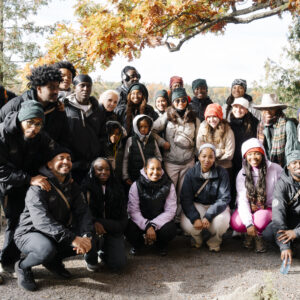Happy Ocean Week!
“All that we do is touched with ocean,” wrote the American poet Richard Wilbur, and this is especially true for a country like Canada, with oceans on three sides and the longest coastline in the world. During Ocean Week (June 1st to 9th) Nature Canada is celebrating all things oceanic… and you’re invited!
Killer Whales Surfacing in Ottawa
Ever wanted to swim with killer whales? From June 2 to 9, you’ll have a chance to — virtually — at the Canadian Museum of Nature in Ottawa.

Experience the world of Southern Resident Killer Whales at the Canadian Museum of Nature’s augmented reality exhibit, Critical Distance.
Take a deep breath and enter the blue-green depths of BC’s Salish Sea. Swimming close to a pod of killer whales, you hear rusty hinges working, gulls crying, synthesizers warbling and trilling, and now and then the sound of someone tying a knot in a balloon. These are the underwater vocalizations of killer whales, and they form the backdrop of a dazzling “immersive augmented reality experience” called Critical Distance. Nature Canada is partnering with Saturna Island Marine Research and Education Society (SIMRES), Vision 3 Ltd, and the Environmental Restoration Department at Western University to bring this exhibit to the museum.
Museum visitors will be transported to BC’s Salish Sea and follow the story of a young orca named Kiki. An endangered Southern Resident Killer Whale and denizen of the Southern Strait of Georgia, Kiki bears the burden of an uncertain future. Museum-goers will learn about threats to the Southern Residents and find out how to protect the whales by supporting the effort to make the Southern Strait of Georgia a protected area.
Help us make waves — become an Ocean Defender!
Members of Parliament will also have a chance to swim with killer whales on June 5th, when Nature Canada brings Critical Distance to Parliament Hill. Not only will parliamentarians and guests be able to experience the sound-rich world of the whales (even richer than Question Period!), but they will have the chance to commit to protecting the Southern Strait of Georgia and to push for a clear roadmap to protect 30% of the ocean by 2030. (You can do the same by sending a letter to the federal government asking for a National Biodiversity Strategy that will get us to “30×30.”)
Send the letter to halt and reverse nature loss.
And speaking of taking action for the ocean, Nature Canada’s partner Coastal Restoration Society (CRS) is tackling a major threat to marine health — “ghost gear” (abandoned, lost, and discarded fishing gear).
Tracking the (Very Material) Ghosts

Shoreline retrieval work at Pinkey’s Point, Nova Scotia, as part of Coastal Restoration Society’s Ghost Gear Project. (Photo courtesy of Coastal Restoration Society)
All over the world, the ocean is at risk from ghost gear. Such debris can be fatal to fish, marine mammals and other sea life; it also breaks down into other forms of pollution such as microplastics.
Supported by the Department of Fisheries and Ocean’s Ghost Gear Fund, CRS recently launched a major collaborative effort to clean up ghost gear in Nova Scotia. Hurricane Fiona, which hit Atlantic Canada in the fall of 2022, exacerbated the quantity and distribution of ghost gear in the region.
From the project’s inception in May 2023, CRS engaged in consultations with regional stakeholders, including 17 Mi’kmaq communities, to understand the local impact of Hurricane Fiona. Indigenous partners highlighted critical food, social, and ceremonial areas, while organizations such as the Nature Trust of Nova Scotia and the Department of Natural Resources identified areas of conservation concern.
CRS’s “Indigenous First” mandate led them to offer job opportunities and contracts to Indigenous community members. Involving Indigenous partners in planning, surveying, and retrieval activities allowed CRS to benefit from their local knowledge and expertise while supporting their traditional livelihoods, cultural practices, and food security. The project employed 63 individuals, 65% identifying as Indigenous and 35% female—significantly higher representation than in the broader fishing industry.

A helicopter helps retrieve ghost gear at Bear Cove, Nova Scotia. Helicopters were used for islands that the transport vessels could not access. (Photo: Coastal Restoration Society)
Forging connections—with local fishers, non-profits, government agencies, and academia—drove the project forward. Partnering with Indigenous-owned Glooscap Health and Safety Consulting, CRS ensured its Occupational Health and Safety standards met regional requirements. Tailored training programs for Indigenous and new workers enhanced project safety and provided capacity-building opportunities in ghost gear surveying and retrieval operations, environmental monitoring, Remotely Operated Vessel (ROV) operation, and side-scan sonar technology.
Over six months (from May to October 2023), the project removed 158 tonnes of ghost gear, including 3,550 lobster traps!
Through its membership in the Fishing Gear Coalition of Atlantic Canada, CRS will continue to advocate for sustainable end-of-life processing solutions and ongoing funding to create a lasting positive impact on our marine environments and the communities that depend on them.
Gully Gee… It’s Been Twenty Years
Finally, we have a birthday to celebrate: the Gully Marine Protected Area turns twenty this year.
The Gully is truly a seascape of wonder. Located about 200 kilometres off Nova Scotia to the east of Sable Island, it’s the largest undersea canyon in the western North Atlantic. Over 65 kilometres long and 15 kilometres wide, it’s home to endangered Northern bottlenose whales as well as fifteen other species of whales and dolphins. Sharks, tunas, swordfish, and seabirds inhabit surface waters, while halibut, skates, white hake and lanternfish can be found as deep as one kilometre. The ocean floor supports crabs, anemones, brittle stars, and about 30 species of cold-water corals.

The SeaBlue coalition, to which Nature Canada belongs, recently held a very successful birthday celebration for the Gully, which included a knitting contest to crochet a coral, sponge or other deep-sea inhabitant of this area.
Canadians can be proud of all the work that went into safeguarding the Gully, the nation’s first marine protected area, but much remains to be done. We are still far from achieving our goal of protecting 30 percent of the ocean by 2030. You can help by becoming an Ocean Defender and joining other patriots of the sea. We all hold the ocean in the palm of our hands; let’s not let it slip through our fingers!



